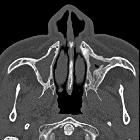chronische Sinusitis













 nicht verwechseln mit: kraniofaziale fibröse Dysplasie
nicht verwechseln mit: kraniofaziale fibröse DysplasieChronic sinusitis refers to ongoing long-term sinus infection-inflammation that often develops secondary to a prolonged/refractory acute sinus infection.
Epidemiology
It most commonly affects young to middle-aged adults but can uncommonly also affect children.
Clinical presentation
Chronic sinusitis is defined clinically as a sinonasal infection lasting more than 12 weeks. Patients may present with symptoms of sinusitis such as nasal obstruction, nasal discharge, facial pain, headache, halitosis, anosmia, etc.
It is worth noting is no definite correlation between symptoms and imaging findings of chronic sinusitis and that endoscopic chronic sinusitis may have no imaging correlation as the mucosa is best appreciated on the former .
Pathology
Etiology
- paranasal sinus anatomical variants obstructing drainage (see below)
- sinonasal polyposis
- chronic allergy
- chronic infection:
- chronic bacterial sinusitis
- chronic allergic fungal sinusitis
- cystic fibrosis
- odontogenic
A study was done on 150 patients of chronic rhinosinusitis and found the following anatomical variants :
- concha bullosa (30%)
- posterior nasal septal deviations (25%)
- uncinate process variations (25%)
- paradoxical middle turbinate (10%)
- agger nasi cells (10%)
- Haller cells (9%)
Radiographic features
CT
A characteristic feature on CT sinuses is sclerotic thickened bone (hyperostosis) involving the sinus wall from a prolonged mucoperiosteal reaction. Intrasinus calcification may be present. The presence of opacification is not a good discriminator from an acute sinus infection.
There are five main patterns of chronic inflammatory disease that classify the disease into distinct anatomical/pathological groups and are dependent on the drainage pathways affected. This classification helps the surgeon to select the type of surgery needed :
- ostiomeatal complex pattern: maxillary sinus, anterior ethmoid air cells, and frontal sinuses are affected due to obstruction of the ostiomeatal complex
- infundibular pattern: isolated obstruction to the ethmoid infundibulum and/or maxillary sinus ostium
- sphenoethmoidal recess pattern: inflammatory changes in the sphenoethmoidal recess obstruct the sphenoid sinus in isolation or in conjunction with the posterior ethmoidal air cells
- sinonasal polyposis pattern: extensive polyps are occupying the nasal cavity and the paranasal sinuses
- sporadic pattern: no clear pattern could be identified with random mucosal thickening, polyps
Treatment and prognosis
Functional endoscopic sinus surgery (FESS) has revolutionised the approach and treatment of chronic rhinosinusitis. Certain anatomical variations are thought to be predisposing factors for the development of sinus disease and it is necessary for the surgeon to be aware of these variations, especially if the patient is a candidate for FESS .
Siehe auch:
- Sinusitis
- kraniofaziale fibröse Dysplasie
- Sinunasale Aspergillose
- chronisch invasive fungale Sinusitis
- chronisch granulomatöse fungale Sinusitis
- sinunasale Tuberkulose
und weiter:

 Assoziationen und Differentialdiagnosen zu chronische Sinusitis:
Assoziationen und Differentialdiagnosen zu chronische Sinusitis:


